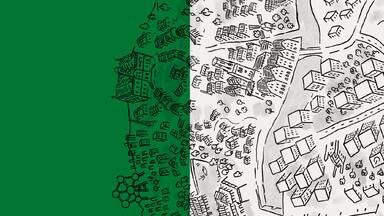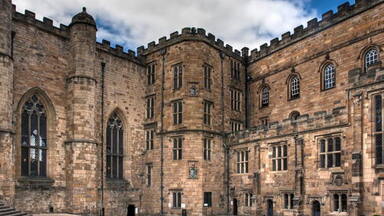Community-led urban planning in Durham (United Kingdom)
The City of Durham Neighbourhood Plan was developed between 2014 and 2021 following a comprehensive community-centred approach, which included a Neighbourhood Forum, extensive consultations and a public referendum. The resulting plan aims to balance conservation and development in and around the World Heritage site, with a special consideration to the property’s Outstanding Universal Value, as well as local heritage values.
About the city of Durham
Durham is a historic university city located in northeast England, and one of the best-known medieval cityscapes in Europe. Although small in size, with a population of 43,000 in the urban area and a total area of 32 km2, the town acts as the administrative centre for the Durham County, with a population of approximately 500,000 people. The city is home to the World Heritage site Durham Castle and Cathedral, inscribed on the World Heritage List in 1986 under criteria (ii), (iv) and (vi).
Durham Cathedral was built in the late 11th and early 12th centuries to house the relics of St Cuthbert (evangelizer of Northumbria) and the Venerable Bede. It attests to the importance of the early Benedictine monastic community and is the largest and finest example of Norman architecture in England. The innovative audacity of its vaulting foreshadowed Gothic architecture. Behind the cathedral stands the castle, an ancient Norman fortress which was the residence of the prince-bishops of Durham.
According to the site manager, the main challenge facing the World Heritage site in Durham is the need to balance heritage conservation with the needs of a living, modern and evolving city with increasing development pressures.
Regarding the managing framework of the World Heritage site, the property does not have a designated buffer zone. The management of the property for its Outstanding Universal Values and other heritage values relies on the statutory protection of the Durham City Centre Conservation Area designation. Both the Castle and Cathedral are protected by designation, the Castle being Grade 1 listed and the Cathedral being Grade 1 listed and protected through the ecclesiastical protection system. However, the 2019 ICOMOS Technical Review on the proposed construction of a new business school located within the Conservation Area raised questions on the need to redefine the boundaries and buffer zone of the property, in particular to preserve the settings and context of the World Heritage site.
City of Durham Neighbourhood Plan
The City of Durham Neighbourhood Plan seeks to control and encourage sustainable urban development that can meet current needs without compromising those of future generations. The vision endeavours all new development to contribute to the long-term sustainable future of Durham City, by ensuring a balanced relationship among environmental, social and economic outcomes. Its area of action includes the World Heritage site “Durham Castle and Cathedral”.
The Neighbourhood Plan is part of the statutory local development framework, alongside the County Durham Plan. Its implementation is under the responsibility of the Parish Council. The plan is expected to cover the period until 2035, subject to reviews every five years. One of the main themes of the plan is the incorporation of urban heritage values and attributes into the planning framework. This includes both the World Heritage site, covered in the Policy H1: Protection and Enhancement of the World Heritage, as well as other conservation areas and wider heritage values.
Neighbourhood Plans were introduced into the English planning system by the Localism Act (2011). They sit alongside the main plan that covers a larger area. Therefore, the Durham City Neighbourhood Plan covers only the area of the City of Durham civil parish and it is complementary to the County Durham Plan that covers the whole county. The local planning authority is Durham County Council; when it takes planning decisions, it must follow the policies in both the County and Neighbourhood Plans.
Neighbourhood plans can go into more detail for their local area. The Durham City Neighbourhood Plan contains a policy (H1) that protects and enhances the World Heritage site in more detail than policy 45 of the County Durham Plan. It also contains several policies (H2, G1 – G3) that protect and enhance the urban Conservation Area that is the immediate setting of the World Heritage site, as well as the green areas, including the riverbanks that define the natural setting.
The procedure for the development of the Neighbourhood Plan followed the standard procedure for neighbourhood plans, as defined by the Localism Act 2011 and the Durham County Council:
- Step one: Defining the neighbourhood. The neighbourhood area was established as the area covered by the Durham City Parish Council. The Durham City Neighbourhood Planning Forum was set up by a group of volunteers prepared to work on developing the plan.
- Step two: Prepare a draft neighbourhood plan. Once the neighbourhood area was approved and designated, the Neighbourhood Planning Forum prepared the plan. This involved:
- Gathering information about the neighbourhood area, considering local plans, local and national planning policies and any other relevant legislation.
- Establishing the community's aspirations and priorities.
- Identifying the key themes and setting out a clear purpose, goals and objectives for the plan.
- Drafting planning policies to help deliver the objectives of the plan.
- Understanding whether the plan was likely to have a significant environmental impact.
- Step three: Publicity and consultation. Before formally submitting the plan to the council for examination, the Neighbourhood Planning Forum carried out an iterative process of consultation, inviting comments from people who live, work and carry out business in the area, as well as the Durham County Council and regional and national organisations and agencies. The methods used include:
- Leaflets delivered to every household
- Drop-in sessions
- Discussions with focus groups
- Paper and online questionnaires
After the consultations, the Neighbourhood Planning Forum adjusted the proposal according to the responses received. All meeting minutes, consultation responses and documents produced are publicly available on the website npf.durhamcity.org.uk/.
- Step four: Formally submitting the neighbourhood plan proposal to Durham County Council. The Council ensured that the proposal complies with all relevant legislation, and that all necessary processes and procedures have been carried out. Once the Council ascertained that the plan was in accordance with the legal requirements, they:
- Publicised the plan for a minimum of 6 weeks and invited representations.
- Notified specific regional and national organisations and agencies.
- Step five: Independent examination. The plan was checked by an independent examiner to see whether it met set tests known as 'basic conditions'.
- Step six: Referendum. Everyone living in the area of coverage of the neighbourhood plan, who is registered to vote in local elections, was entitled to vote in the referendum. For the neighbourhood plan to proceed, more than 50% of the vote in the referendum had to be in favour of the plan. The Neighbourhood Planning Referendum for the City of Durham Neighbourhood Plan was held on Thursday 6 May 2021. More than 5,000 residents participated in the Referendum, of which 85.6% voted to approve the Neighbourhood Plan.
- Step seven: Bring the neighbourhood plan into force. After the referendum, the County adopted the plan as part of the statutory development plan for the area at a meeting of the Council on 23 June 2021.
The development of the Neighbourhood Plan was rooted on the principles of participatory planning and community involvement. Consequently, managing the large number of stakeholders, such as Durham County Council, Historic England or Durham University, became a major challenge. On the other hand, the project was mostly carried by a volunteer group, which required sustained, long-standing support and commitment from its individual members. Finally, not all proposals from the community consultations were able to be included in the Neighbourhood Plan. In order to include all community views, community proposals that were not amenable to formulation as planning policies were collated in the companion document Looking Forwards.
Following the development of the Neighbourhood Plan, a minor boundary extension of the World Heritage site was submitted to the World Heritage Committee. The Committee referred the proposal back to the State Party and recommended that the State Party give consideration to creating a buffer zone, based on the existing Conservation area, in order to protect all the “key views to and from the Castle, Cathedral and town” (Decision 44 COM 8B.59).
Sources: Adam Shanley, Parish Clerk, City of Durham Parish Council; Jane Gibson, World Heritage site manager; John Lowe and Sue Childs, Durham City Neighbourhood Planning Forum, 2021.
Contribution towards the implementation of the 2011 Recommendation on the Historic Urban Landscape
The project could contribute to the implementation of the Historic Urban Landscape approach thanks to its:
- Incorporation of heritage values and attributes into urban development plans
- Consideration of urban heritage conservation within the framework of sustainable development
- Development of extensive community and stakeholder consultation processes prior to the approval of planning schemes
Historic Urban Landscape Tools
Civic engagement tools Knowledge and Planning tools Regulatory systems
Contribution towards Sustainable Development
If fully implemented in accordance with the described plans, the initiative could contribute towards Sustainable Development and the Sustainable Development Goals.

Goal 11. Make cities and human settlements inclusive, safe, resilient and sustainable.
- Target 11.3: the initiative aims to enhance inclusive and sustainable urbanisation and participatory, integrated and sustainable human settlement planning and management.
- Target 11.4: the initiative aims to strengthen efforts to protect and safeguard the world’s cultural and natural heritage.
- Target 11.7: the initiative aims to improve universal access to safe, inclusive and accessible, green and public spaces.

Goal 16. Promote peaceful and inclusive societies for sustainable development, provide access to justice for all and build effective, accountable and inclusive institutions at all levels.
- Target 16.7: the initiative aims to promote inclusive, participatory and representative decision-making at the local level.

Goal 17. Strengthen the means of implementation and revitalise the global partnership for sustainable development.
- Target 17.17: the initiative aims to promote public, public-private and civil society partnerships, building on the experience and resourcing strategies of partnerships.
Note: the described potential impacts of the projects are only indicative and based on submitted and available information. UNESCO does not endorse the specific initiatives nor ratifies their positive impact.
To learn more
- Visit the City of Durham Neighbourhood Plan website.
- Read the companion document “Looking forwards”.
- Visit the Durham County Council’s Neighbourhood planning step by step process.
- Visit the website of the Durham World Heritage Site.
- Watch the presentation of this case study during the Celebration of the 10th Anniversary of the UNESCO Recommendation on the Historic Urban Landscape in June 2021.
Contact
City of Durham Parish Council.Cover image: Ko Hon Chiu Vincent. Permanent URL: whc.unesco.org/en/documents/138167
Note: The cases shared in this platform address heritage protection practices in World Heritage sites and beyond. Items being showcased in this website do not entail any type of recognition or inclusion in the World Heritage list or any of its thematic programmes. The practices shared are not assessed in any way by the World Heritage Centre or presented here as model practices nor do they represent complete solutions to heritage management problems. The views expressed by experts and site managers are their own and do not necessarily reflect the views of the World Heritage Centre. The practices and views shared here are included as a way to provide insights and expand the dialogue on heritage conservation with a view to further urban heritage management practice in general.


 11 Sustainable Cities and Communities
11 Sustainable Cities and Communities